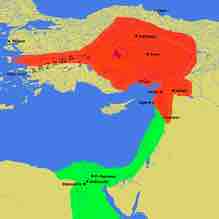The New Kingdom of Egypt, also referred to as the Egyptian Empire, is the period in ancient Egyptian history between 1550-1070 BCE, covering the Eighteenth, Nineteenth, and Twentieth Dynasties of Egypt. The New Kingdom followed the Second Intermediate Period, and was succeeded by the Third Intermediate Period. It was Egypt's most prosperous time and marked the peak of its power.
The Nineteenth and Twentieth Dynasties (1292-1069 BCE) are also known as the Ramesside period, after the eleven pharaohs that took the name of Ramesses. The New Kingdom saw Egypt attempt to create a buffer against the Levant and attain its greatest territorial extent. This was possibly a result of the foreign rule of the Hyksos during the Second Intermediate Period
The Eighteenth Dynasty (c. 1543-1292 BCE)
The Eighteenth Dynasty, also known as the Thutmosid Dynasty, contained some of Egypt's most famous pharaohs, including Ahmose I, Hatshepsut, Thutmose III, Amenhotep III, Akhenaten (c. 1353-1336 BCE) and his queen Nefertiti, and Tutankhamun. Queen Hatshepsut (c. 1479 - 1458 BCE) concentrated on expanding Egypt's external trade by sending a commercial expedition to the land of Punt, and was the longest-reigning woman pharaoh of an indigenous dynasty. Thutmose III, who would become known as the greatest military pharoah, expanded Egypt's army and wielded it with great success to consolidate the empire created by his predecessors. These victories maximized Egyptian power and wealth during the reign of Amenhotep III. It was also during the reign of Thutmose III that the term "pharaoh," originally referring to the king's palace, became a form of address for the king.
One of the best-known Eighteenth Dynasty pharaohs is Amenhotep IV (c. 1353-1336 BCE), who changed his name to Akhenaten in honor of Aten and whose exclusive worship of the deity is often interpreted as the first instance of monotheism. Under his reign Egyptian art flourished and attained an unprecedented level of realism. Toward the end of this dynasty, the Hittites had expanded their influence into Phoenicia and Canaan, the outcome of which would be inherited by the rulers of the Nineteenth Dynasty.
Bust of Akhenaten
Akhenaten, born Amenhotep IV, was the son of Queen Tiye. He rejected the old Egyptian religion and promoted the Aten as a supreme deity.
The Nineteenth Dynasty (c. 1292-1187 BCE)
New Kingdom Egypt would reach the height of its power under Seti I and Ramesses II, who fought against the Libyans and Hittites. The city of Kadesh was a flashpoint, captured first by Seti I and then used as a peace bargain with the Hatti, and later attacked again by Ramesses II. Eventually, the Egyptians and Hittites signed a lasting peace treaty.

Egyptian and Hittite Empires
This map shows the Egyptian (green) and Hittite (red) Empires around 1274 BCE.
Ramesses II had a large number of children, and he built a massive funerary complex for his sons in the Valley of the Kings. The Nineteenth Dynasty ended in a revolt led by Setnakhte, the founder of the Twentieth Dynasty.
Temple of Ramesses II
Detail of the Temple of Ramesses II.
The Twentieth Dynasty (c. 1187-1064 BCE)
The last "great" pharaoh from the New Kingdom is widely regarded to be Ramesses III. In the eighth year of his reign, the Sea Peoples invaded Egypt by land and sea, but were defeated by Ramesses III.
The heavy cost of warfare slowly drained Egypt's treasury and contributed to the gradual decline of the Egyptian Empire in Asia. The severity of the difficulties is indicated by the fact that the first known labor strike in recorded history occurred during the 29th year of Ramesses III's reign, over food rations. Despite a palace conspiracy which may have killed Ramesses III, three of his sons ascended the throne successively as Ramesses IV, Ramesses VI and Ramesses VIII. Egypt was increasingly beset by droughts, below-normal flooding of the Nile, famine, civil unrest, and official corruption. The power of the last pharaoh of the dynasty, Ramesses XI, grew so weak that, in the south, the High Priests of Amun at Thebes became the de facto rulers of Upper Egypt. The Smendes controlled Lower Egypt even before Ramesses XI's death. Menes eventually founded the Twenty-first Dynasty at Tanis.